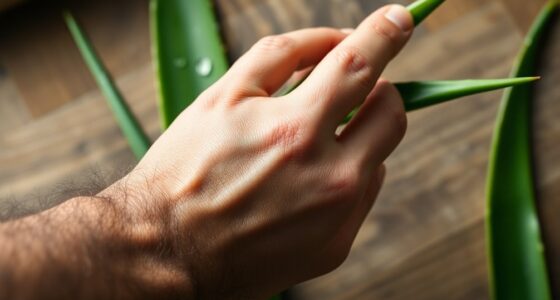To set yourself up for success when pan-searing steak for the first time, start by choosing a well-marbled cut like ribeye and letting it reach room temperature. Use a hot cast iron or stainless steel pan with high-smoke point oil, season simply with salt and pepper, and sear each side until a golden crust forms. Rest the steak before slicing to lock in juices. For detailed tips, continue exploring how to master each step for perfect results.
Key Takeaways
- Select a well-marbled, high-quality steak and bring it to room temperature for even cooking.
- Preheat your pan thoroughly on medium-high heat until hot enough to sear.
- Dry the steak completely with paper towels to promote crust formation and reduce splatter.
- Season simply with salt and pepper, or apply your preferred marinade for added flavor.
- Rest the steak for at least 5 minutes after searing to retain juices and enhance tenderness.
Choosing the Right Cut of Steak
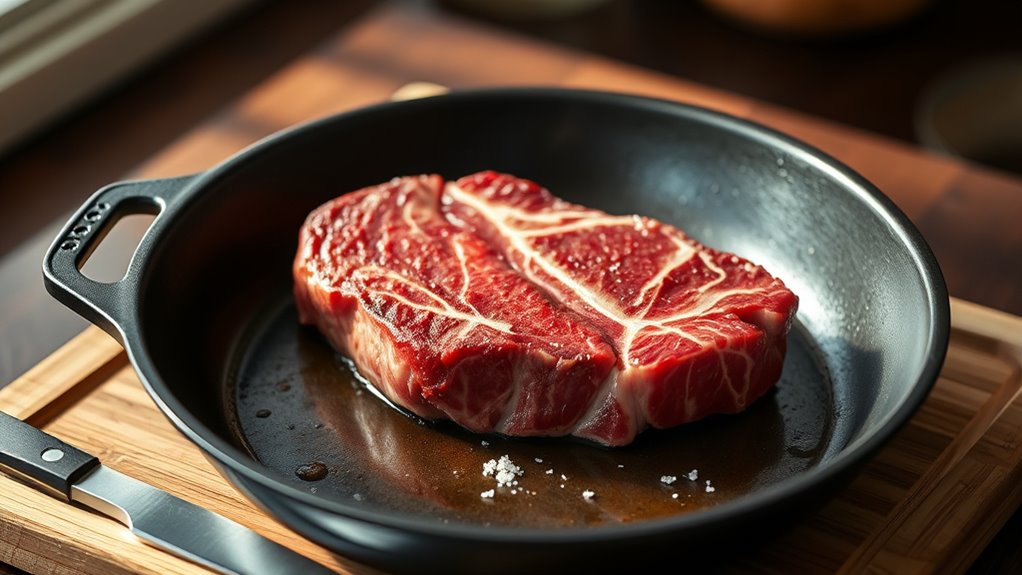
Choosing the right cut of steak is essential for a successful pan-searing experience. Your focus should be on marbling quality, as fat distribution directly impacts flavor and tenderness. Well-marbled steaks, like ribeye or New York strip, melt in your mouth and develop a rich crust. Regional steak varieties offer different textures and flavors; for instance, American steaks often emphasize marbling, while Argentine cuts highlight leaner profiles. Opt for cuts with visible streaks of fat throughout the meat, as this guarantees juiciness and enhances searing results. Avoid overly lean options like sirloin if you’re aiming for a tender, flavorful steak. Selecting the right cut based on marbling and regional variety sets the foundation for a perfectly seared, delicious steak. To maximize tenderness and flavor, choose cuts that are known for their marbling quality and regional characteristics.
Preparing Your Steak for Searing

Before you start searing, make sure you’ve chosen the right cut of steak for your desired doneness. Next, pat the meat dry with paper towels to remove excess moisture, which helps achieve a perfect crust. Proper preparation sets the stage for a beautifully seared, flavorful steak. Using the right cut of steak can also influence how well your searing process goes and the overall outcome.
Selecting the Right Cut
To achieve a perfect sear, selecting the right cut of steak is essential. Look for cuts with good marbling quality, which guarantees flavor and juiciness. Thicker steaks, around 1.5 to 2 inches, give you more control over the searing process and help prevent overcooking. For a first-timer, ribeye or sirloin are excellent choices due to their balance of marbling and tenderness.
| Cut Type | Marbling Quality | Ideal Thickness |
|---|---|---|
| Ribeye | High | 1.5–2 inches |
| Sirloin | Moderate | 1.5 inches |
| Filet Mignon | Low to Moderate | 1.5 inches |
Properly Drying the Steak
Ensuring your steak is thoroughly dried is essential for a perfect sear, as moisture on the surface can prevent that desirable crust from forming. Patience and timing are key; take the time to pat your steak dry with paper towels, especially on the edges. Removing excess moisture allows heat to cook evenly and promotes better browning. Be mindful of kitchen safety—keep towels away from open flames or hot surfaces to prevent accidents. Once dry, let the steak rest briefly before searing, giving it time to reach room temperature and ensuring a more even cook. Properly dried steak not only improves crust formation but also reduces splattering, making your cooking safer and more controlled. This step is simple but vital for steak perfection. Proper drying techniques are also crucial in achieving optimal results in your cooking process.
Selecting the Perfect Pan and Equipment
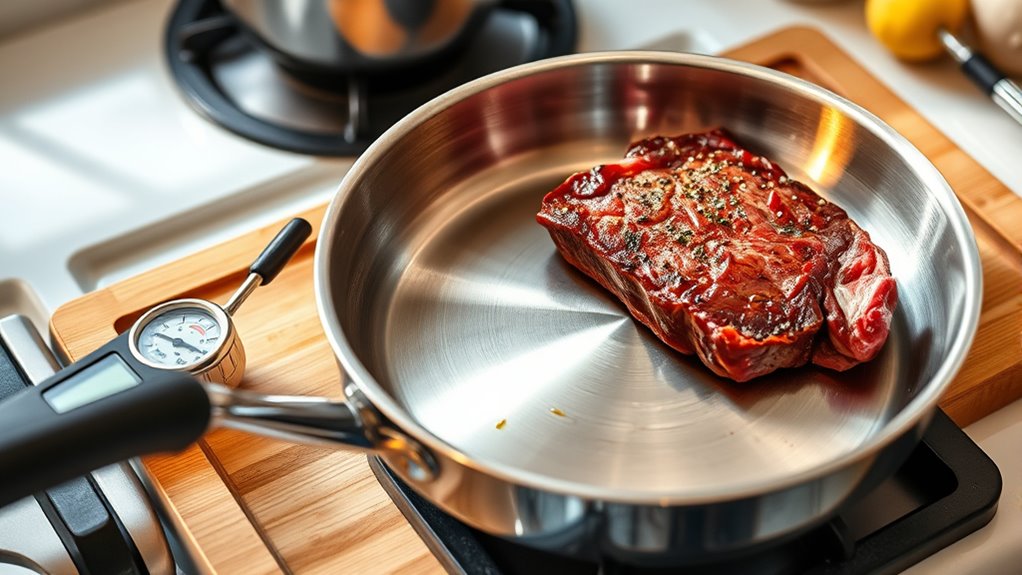
To get a perfect sear, choosing the right pan and tools is key. You’ll want a pan made from materials that distribute heat evenly, like cast iron or stainless steel. Make sure you have essential kitchen tools on hand to handle the steak safely and efficiently.
Choosing the Right Pan Material
Choosing the right pan material is essential for achieving a perfectly seared steak. Your choice impacts heat distribution, retention, and the final crust. Cast iron pans excel at retaining heat and creating a crispy exterior, making them ideal for searing. Stainless steel pans heat quickly and evenly, allowing precise control during cooking. Both materials are durable and versatile, but your decision depends on your cooking style. Additionally, understanding heat retention properties can help you select the best pan for consistent results.
Essential Kitchen Tools
Selecting the right pan and equipment is essential for achieving a perfect sear and delicious steak. You’ll want a heavy-duty, preferably cast iron or stainless steel pan that distributes heat evenly. Before cooking, gather high-smoke point cooking oil like vegetable or canola oil to prevent burning. A reliable meat thermometer is vital for checking internal temperature and ensuring the steak reaches your desired doneness. Use the thermometer’s probe to monitor the thickest part of the meat without cutting into it, which helps maintain juiciness. Having these tools ready makes your process smoother and more consistent. With the right pan, cooking oil, and a good meat thermometer, you set yourself up for a perfectly seared, flavorful steak every time.
Mastering the Right Seasoning and Marinades
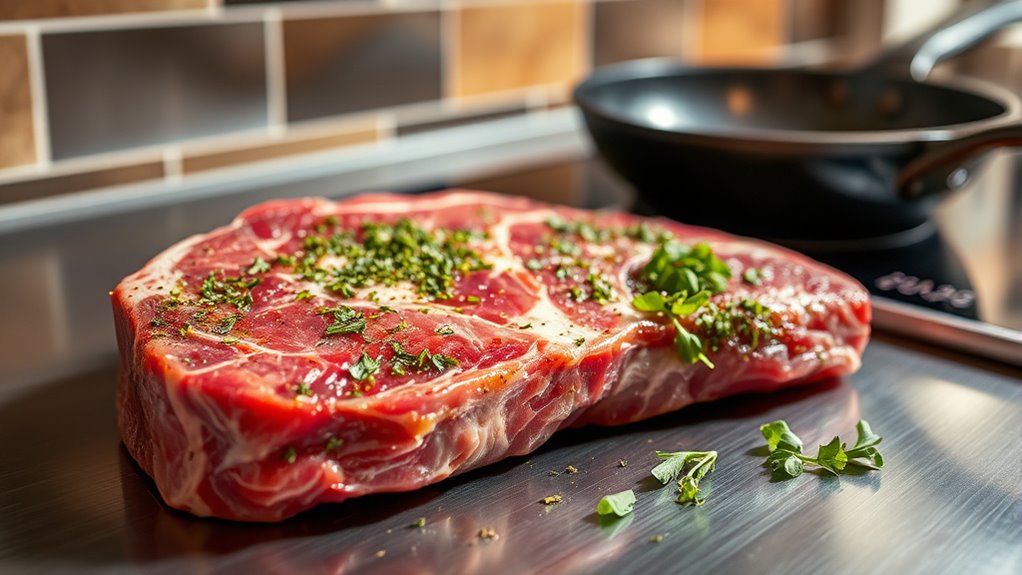
Getting the seasoning right is essential for enhancing the natural flavors of your steak. Use seasoning techniques like a simple salt and pepper rub or a blend of herbs and spices to add depth. Marinade options can also elevate your steak—try a mixture of soy, garlic, and olive oil for richness or a citrus-based marinade for brightness. Proper seasoning builds a flavor foundation that complements the searing process. Think of each choice as adding a layer of excitement to your meal. Here’s a quick overview:
| Flavor Intensity | Technique | Marinade Options |
|---|---|---|
| Mild | Light salt and pepper | Lemon herb marinade |
| Bold | Spice rubs, herbs | Balsamic and garlic marinade |
| Savory | Umami-rich seasonings | Soy and ginger marinade |
| Fresh | Citrus and herbs | Lime and cilantro marinade |
| Rich | Butter and herbs | Red wine marinade |
Additionally, mastering the correct changing gears on your gravel bike can help you maintain control and ensure an even sear during cooking.
Properly Heating the Pan for Optimal Searing
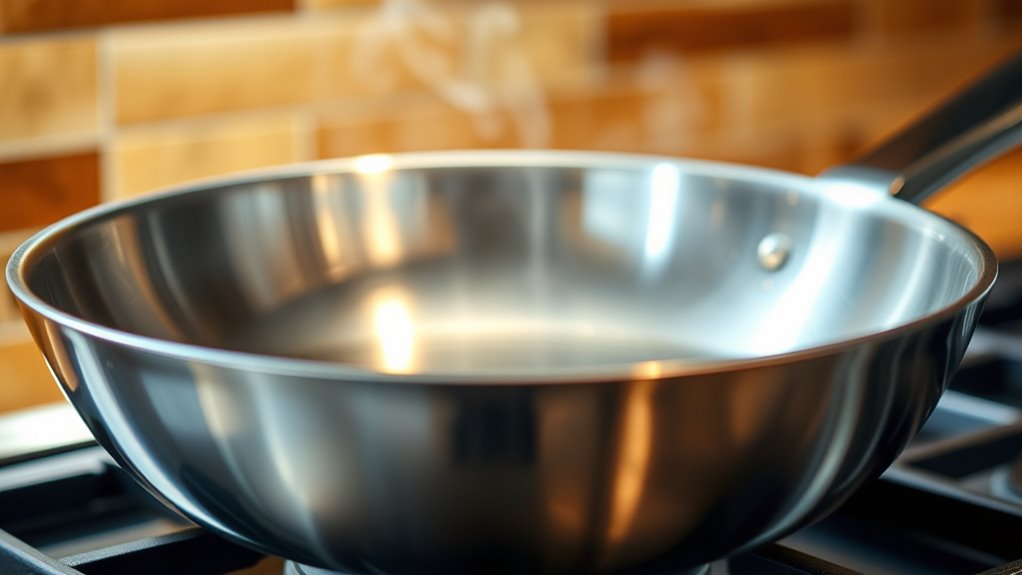
To achieve a perfect sear, you need to guarantee your pan is heated to the right temperature before adding the steak. Check the pan temperature by sprinkling a few drops of water—if they dance and evaporate quickly, you’re close. Proper heat distribution ensures the entire surface heats evenly, preventing hot spots that can burn the meat or cause uneven searing. Use medium-high heat for most steaks, but adjust based on your stove and pan type. A cast iron skillet retains heat well, providing consistent heat distribution, while thinner pans can heat unevenly. Giving your pan time to reach the right temperature is vital; rushing this step can lead to poor crust formation. When properly heated, your pan will deliver an even, high heat that’s essential for a great sear. Additionally, understanding sound wave influence on heat transfer can help optimize your cooking process for better results.
Techniques for Achieving a Perfect Crust
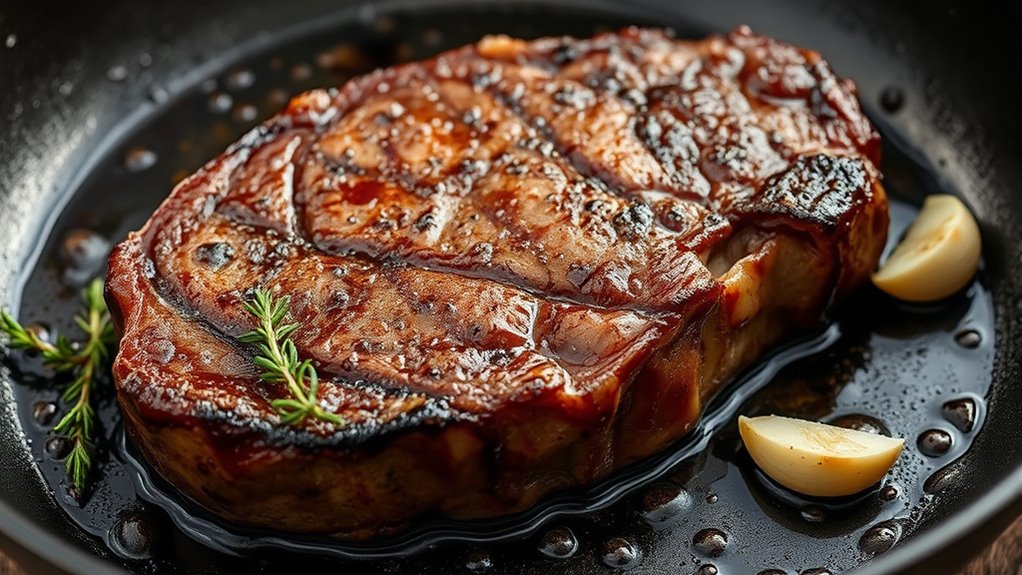
Once your pan is properly heated, the next step is to develop that irresistible, flavorful crust on your steak. To do this, consider the marbling quality—better marbling results in a richer, more evenly browned crust. Confirm your steak’s thickness is appropriate; thicker cuts need more time to sear without overcooking the interior. Pat the steak dry to remove excess moisture, which helps achieve a crisp crust. Use high smoke point oil, like canola or grapeseed, to prevent burning. When placing the steak in the pan, don’t move it prematurely—let the crust form undisturbed for 2-3 minutes per side. A proper sear leverages both marbling and thickness, giving you that perfect, caramelized crust. Additionally, choosing the right cookware material can significantly influence heat retention and overall searing performance.
Resting and Serving Your Steak for Maximum Flavor
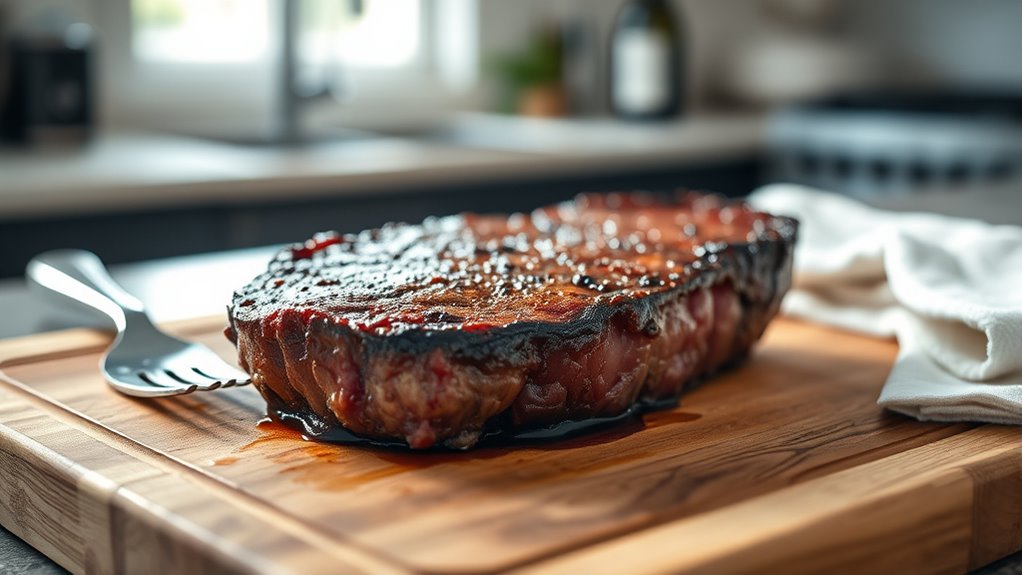
After removing your steak from the pan, it’s essential to let it rest for at least 5 minutes before slicing. Resting allows the juices to redistribute, enhancing flavor infusion and ensuring each bite is juicy and tender. During this time, the steak continues to cook slightly, locking in moisture and maximizing flavor. Proper resting also makes plating presentation easier, as the meat firms up and holds its shape. For the best results, tent the steak loosely with foil to retain heat without steaming. When ready to serve, slice against the grain for maximum tenderness. This final step elevates the overall experience, turning a well-seared steak into a flavorful, visually appealing masterpiece that’s sure to impress. Understanding meat temperature and proper resting techniques can further improve your results.
Frequently Asked Questions
How Do I Know When My Steak Is Cooked to My Desired Doneness?
You’ll know your steak’s cooked to your desired doneness by checking its meat temperature and using doneness indicators. Use a meat thermometer to measure the internal temperature—around 120°F for rare, 130°F for medium-rare, 140°F for medium, 150°F for medium-well, and 160°F for well-done. Also, observe doneness indicators like firmness and color; for example, a rare steak feels soft and cool inside.
Can I Pan-Sear Steak Without Oil or Fat?
Imagine you’re trying to pan-sear steak without oil or fat. While it’s possible, it’s not ideal for even cooking or flavor enhancement. Using a small amount of oil helps create a delicious crust and prevents sticking, especially with lean cuts. Without fat, you risk uneven searing and less flavor. For better results, stick to proper cooking techniques, and a bit of oil will make a noticeable difference.
What Are Common Mistakes to Avoid During Pan-Searing?
Avoid overcrowding the pan, as it lowers the temperature and prevents proper searing. Also, don’t use high heat improperly; too high can burn the outside while leaving the inside undercooked. Instead, preheat your pan correctly and maintain a consistent, medium-high heat. Let the steak sear undisturbed for a few minutes before flipping. These mistakes can ruin your steak’s texture and flavor, so stay attentive and patient.
How Do I Clean and Maintain My Pan After Searing?
Cleaning your pan isn’t just about removing residue; it’s about preserving its longevity. After searing, let it cool, then use hot water and a gentle scrubber for pan cleaning—avoid harsh abrasives. For pan maintenance, season your skillet regularly to prevent sticking and rust. Dry it thoroughly to avoid corrosion. This routine keeps your pan in top shape, ensuring perfect searing every time and extending its lifespan.
Is It Necessary to Use a Thermometer for Perfect Doneness?
You don’t necessarily need a thermometer for perfect doneness, but it’s a helpful tool to guarantee your meat reaches the right temperature. By checking the meat temperature, you can accurately gauge doneness indicators like firmness and color. Relying on a thermometer takes the guesswork out of cooking, giving you consistent results and avoiding over- or under-cooking your steak. It’s a simple step toward mastering steak perfection.
Conclusion
As you step back and admire your perfectly seared steak, it hits you—every detail, from choosing the right cut to resting it just right, played a part. Maybe it’s the sizzle you heard when the pan hit the heat or the aroma that filled your kitchen, reminding you that success is often in the small moments. With each bite, you realize that mastering this process turns cooking into a satisfying, almost effortless art.
Susannah expertise lies in researching and compiling evidence-based content on juicing, nutrition, and overall health. She is committed to ensuring that The Juicery World offers accurate, up-to-date, and trustworthy information to empower readers to take control of their health. Susannah’s goal is to inspire individuals to embrace juicing as a way to nourish their bodies and live their best lives.







